Predicting Preferences for Pedestrian Bridges in Tehran, Iran
1
Department of Landscape Architecture,
Faculty of Design and Architecture,
Universiti Putra Malaysia (UPM),
Serdang,
43400
Selangor D.E.
Malaysia
Corresponding author Email: n.sahraienejad@gmail.com
DOI: http://dx.doi.org/10.12944/CWE.12.3.16
Pedestrian bridges as urban infrastructurs, could play a critical role toimprove aesthetic qualityof urban areas. In Tehran, most of the pedestrian bridges are built in a similar structure regardles to the visual characteristics of their environments. However, many studies haveconfirmed the importance of harmony between aesthetic qualityof the bridges and their context. This study attempts to identify the role of context in aesthetic perception ofpedestrian bridges and to identify the visual attributes that affect the preferences through a photo-questionnaire survey. Therespondentswere 384 students from Tehran's universities and they were asked to rate 34 scenes of similar structure pedestrian bridges in different urban settings. Data were analyzed by using factor analysis to reveal preferences dimensions and the factors that may affect the preferences dimensions. In addition, the participants were asked their opinions regarding attributes that they perceived important for pedestian bridges aesthetic. Subsequently, a multiple regression analysis was employed to examine relationship between preferences and aesthetic attributes.The triagulation of results from preference dimensions and multiple regression analysis reviled the importance of visual attributes in setings of the pedestrian bridges and underlined the role of context in the aesthetic preferences of pedestrian bridges. These factors should be considered during planning and design processes in order to improve aesthetic qualities of pedestrian bridges in urban landscape.
Copy the following to cite this article:
Nejad N. S, Maulan S. B, Kabudarahangi M. Predicting Preferences for Pedestrian Bridges in Tehran, Iran. Curr World Environ 2017;12(3). DOI:http://dx.doi.org/10.12944/CWE.12.3.16
Copy the following to cite this URL:
Nejad N. S, Maulan S. B, Kabudarahangi M. Predicting Preferences for Pedestrian Bridges in Tehran, Iran. Curr World Environ 2017;12(3). Available from: http://www.cwejournal.org/?p=18450
Download article (pdf)
Citation Manager
Publish History
Select type of program for download
| Endnote EndNote format (Mac & Win) | |
| Reference Manager Ris format (Win only) | |
| Procite Ris format (Win only) | |
| Medlars Format | |
| RefWorks Format RefWorks format (Mac & Win) | |
| BibTex Format BibTex format (Mac & Win) |
Article Publishing History
| Received: | 2017-08-01 |
|---|---|
| Accepted: | 2017-11-20 |
Introduction
Pedestrian bridges in urban areas should be considered more than a part of transportation network system because of the iraesthetic quality in urban areas. According to Gottemoeller there are many considerations for design and construction of a bridge such as economy, transmission of forces, constructability, durability and adjacent structures in landscape and properties, and the bridge designers areresponsible for the aesthetic apearance of the pedestrian bridges along with theother considerations1 C. Menn believed that a successful bridge design should not only resulted from a fundamental engineering practice, but also experience of bridge should come form creativity and awareness which are important factors indesigning bridges.2 She summarized the fundamentals of bridge design in urban areas as providing safety, serviceability, economic and elegance (or visual aspects) and defines conceptual design against detailed design while the formersconsidered all the aspects and the latter just focused on safety and serviceability. Minnesota Department of Transportation (MDOT) considers aesthetic of bridges as an important aspectin planning and design of the bridges and they suggested a guideline for bridge design. MDOT stated that aesthetics qualities should not be in the form of calculated value but rather from innate emotions. MDOT further suggested the following model in order to describe the best component in design processes in which a successful bridge can be produced (Fig.1).3
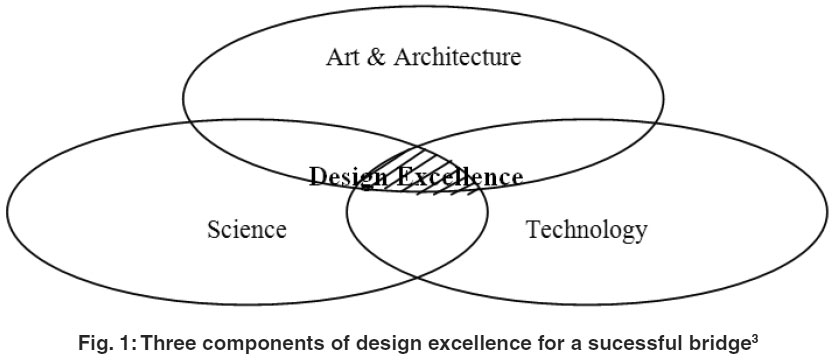 |
|
There are extensive arguments regarding the importance of aesthetic value of the bridges and the issue of aesthetic adds a new dimension to bridges design. According to other researches, one of the outstanding factors related to visual aesthetic of the bridges is the harmonious relationship between the bridges design its surrounding landscapes.4,5,6, 7,8,9,10
Nevertheless, it is argued that the functional efficiency of pedestrian bridges in Tehran is less than 50%, in which it is considered low in efficiency.11 Also Nikoomaram et al., believe that the problem of low efficiency, may caused by inappropriate visual characteristics of bridges.12 Therefore the hypothesis for this study is that the low functional efficiency of pedestrian bridges may potentially caused by non-harmonious relationship between bridges and landscape settings, in which similar form of bridges have been located in every setting with different visual characteristics. So, this study attemptsto understand public preferences for pedestrian bridges in different urban landscapes to find out the role of context invisual prefernces of the pedestrian bridges. (See Fig.2).
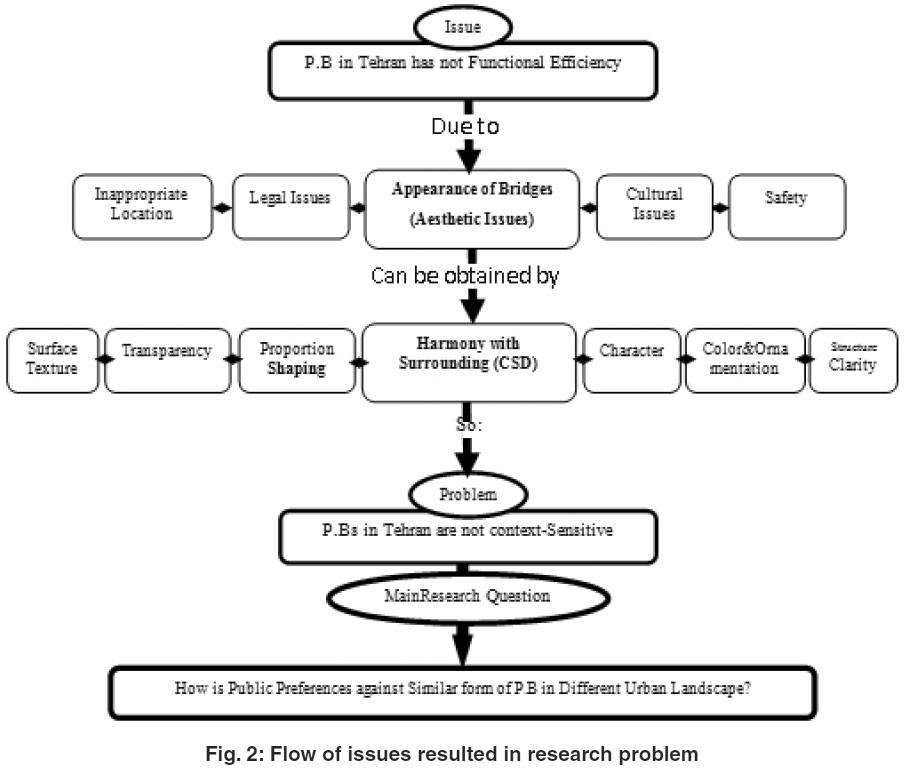 |
|
Based on the above mentioned issues it could be argued that public preferences for pedestrian bridges in urban areas are related to both visual attributes of the scenes and observer perceptions. The study onpreferences for bridges would provide useful information to improveme the aesthetic qualities of pedestrian bridges and enhance functional efficinency of them. However other studies have already focused on aesthetic qualities of bridges in general andevaluation of aesthetic quality of pedestrian bridges in urban areas has not been fully explored especially from preference viewpoint.
Material and Methods
Study employed a photo questionnaire survey to assess Tehranians' preferences for pedestrian bridges. Survey as one of the most sensible types of quantitative methods recognized suitablefor this research which focuses on participants' preferences. On the other hand, This approach is a reasonable and easy method, and has been used in many similarstudies. As Strumse suggested, classifying similarities in landscape preferences across groups can help the development of general guidelines for landscape design.14 In addition, visual quality is a communal experience that depends on people, who are therefore vital in its assessment15 photo-questionnaire method also has been applied to elicit preferences for visual landscape and environment that has been successfully accomplished and tested by numerous studies, which include the comparison of results of photo based and on-site ratings.16,17,18, 19, 20
Data Colletion
For this study, preference for pedestrian bridges in urban area was measured by showing the scenes of pedestrian bridges in urban settings and the respondents were asked to rate their preferences by using four point Likert scale (1= not preferred, 2= preferred a little, 3= preferred, and 4= very much preferred). The 4-point Likert scale was utilized because it is concluded that this scale is an appropriate one for Iranian respondents, as it omits the middle point range.21 In this way over 200 color photographs of bridges in urban areas were collected, using a Canon digital camera with 16.0 mega pixels and a lens with 5× optical zoom. Then using a stratification procedure to be sure of covering adequate variety and repetition of different features and stimulus. Consequently 34 scenes were selected that contained pedestrian bridges in urban areas with a full range of features, so their effects on preferences could be detected clearly. The presentation surveybooklet was designed and six extra scenes (3 at the beginning and 3 at the end) were added, which werenot accounted for in the data analysis. They were just placed there to omit probable bias in this regard. Finally 40 color scenes were arranged in A4 size (21×29.7 cm) booklets, printedin landscape- oriented sheets and presented to the respondents through the survey.
In order to identify factors that may influence people’s preference for pedestrian bridges in urban areas, the survey questionnaire was also designed to obtain participants’ opinion regarding the importance of characteristics that may affect theirpreferences. Altogether, 5 constructs related to characteristics of pedestrian bridges and their surrounding environments were presented to participants and the participants were asked to rate on how much the constructs may affect the visual quality of the pedestrian bridge by using 4 point Likert scale. The constructs were:
Bridges structure (structural characteristics of bridges including their color, slenderness, simplicity, proportion of shape, roughness of structure)
Physical content (the elements present in the scenes including vegetation, building, urban elements, natural features, car and people)
Organization and display of physical elements (the way that physical elements are arranged and displays including: location of buildings and vegetation, diversity of vegetation, connection of buildings and vegetation to each other, the harmonious height of plants, the quality of vegetation, building face and age condition, harmonious of urban elements)
Spatial configuration (the way that spaces, structures, and enclosure are organized including spaciousness of the area, amount of sky-view, harmonious orientations of lines in the scene, width of road, overall assessment of spatial arrangement), and Environmental condition (temporary characteristics of the scene including air pollution, safety situation, population and neatly and cleanliness of the scene).
To conduct a robust statistical analysis, a fair sample size of participants was required. Tehran population based on the last census in 2015 (Tehran, Statistical Centre of Iran) is 8,217,236. This study required sample size a minimum 384 participants24. Due to some practical reason sit was not possible to conduct the survey on streets. Other researches had already selected students as respondents in preference studies, therefore, participants were selected among students from 4 universities in Tehran, which were Tehran University, Shahid Beheshti University, Science and Industry University and Tarbiat Modarres University. To reduce biasness, potential participants from landscape, environmental and design bakgrounds were excluded from the survey.25 Altogether, in line with sample size calculation, 384 students who were in Tehran's residents were surveyed for their preferences of pedestrian bridges.
Statistical Analysis
To analyse collected data from the survey,SPSS (Statistical Program for Social Science) version 19 was selected. Both descriptive and inferential analysis procedures were employed for preference survey. Descriptive statistics included means, standard deviations, frequencies and inferential statistics to show the differences and relationships between research variables. The followings are the processes of data analysis:
Analysis of Preference Dimension,
Visual Attributes Analysis,
Analysis of Multiple Regressions
To reveal meaningful preference dimensions for the scenes with common characteristics and also for preference ratings a factor analysis was conducted. Accordingly, to recognise visual attributes, their means were calculated and ranked.Then to identify the relationship between preferences and visual attributes in order to predict the prefrences based on the visual attributes in the scenes, a regression analysis was conducted.
Results
In the following the results from preference survey, preference dimension analysis, visual attributes and regression analysis is presented.
Preferences for Pedestrian Bridges
The total number of 384 respondents rank 34 scenes of similarly structured pedestrian bridges in different urban landscapes of Tehran. Data was analyzed by using factor analysis to identfy the pattern for preferences and reveal the preference dimension. Then, using Content Identifying Method (CIM),the factors that influence preferences were determined. According to the factor analysis, eight dimensions were identified and then the dimensions were named by a group of PhD candidates from Faculty of Design and Architecture, University Putra Malaysia (UPM). The identified dimensions ranked according to their mean scores which were ranged between 2.52 to 1.72.
Preference dimension 1 (sharp colors with different form of bridges) has the highest mean (Mean=2.52, Sd=0.78) and preference dimension 8 (opaque color of bridge in arid area) has the lowest (Mean=1.72, Sd=0.70). Hence in a four point scale, 2.5 is at the middle point, the mean score for the most prefered dimension (Mean= 2.52) can be considered as moderate.It means none of these bridges is strongly preferred by the respondents, which would be further discussed through the discussion part.In following the preference dimnensions and their contents are described briefly
Preference dimension 1. Sharp Colors with different form of bridges: The scenes in this dimension are similar because ofsharp colors appearing of stairs of bridges (different form of bridges), high amount of well mentained vegetation especially in front of the bridges, and combination with similar urban furnitures such as bus station, gas station or other urban stands. (Fig. 3).
 |
|
Preference Dimension 2. Sharp blue color of bridges with connected buildings around: In fact all of the pedestrian bridges in this dimension have a sharp blue color on ceilings; the arrangement of buildings behind the bridges is similar to each others and they all are connected and harmonious in height. Urban elements have highly presented in the scenes and are mostly visible (e.g.street railings and fences) (Fig. 4).
 |
|
Preference Dimension 3. Light blue color of bridge with connected vegetation around: The common characteristics of the scenes in this dimension are relate to the ceiling’s light blue color. The bridge’ structures are mostly slender. In this dimension, good quality vegetation has visibly presented in the scenes (mostly in front of the bridges). The buildings are the other significant content in this dimension. the buildings are unique in terms of form, color or arrangement and they are visibly presented in the scenes. There are also some similar urban infrastructures i.e electric installation, cables and etcvisible in all the scenes (Fig. 5).
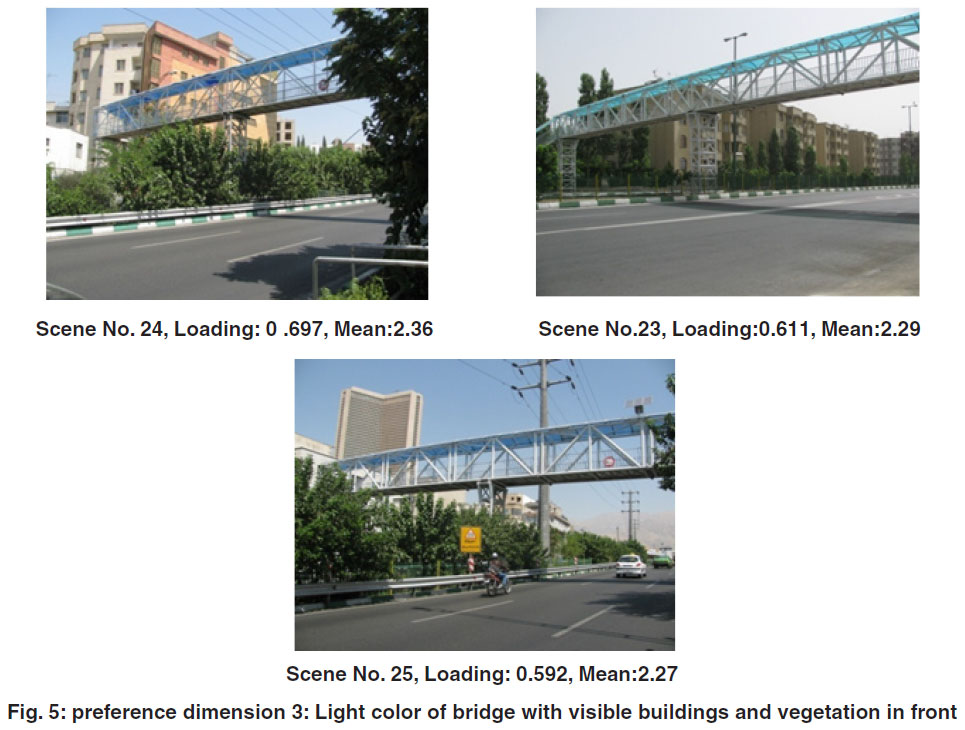 |
|
Preference Dimension 4. Long span bridges with urban infrastructures around: The common characteristics of the scenes in this dimension related to the long span of bridges in which they generally are located on highways or wide roads. The buildings have located beside the bridges, and some urban elements presented in the scenes in a similar way such as electric facilities above the bridges. The vegetation in low amount has also presented in the scenes (Fig. 6).
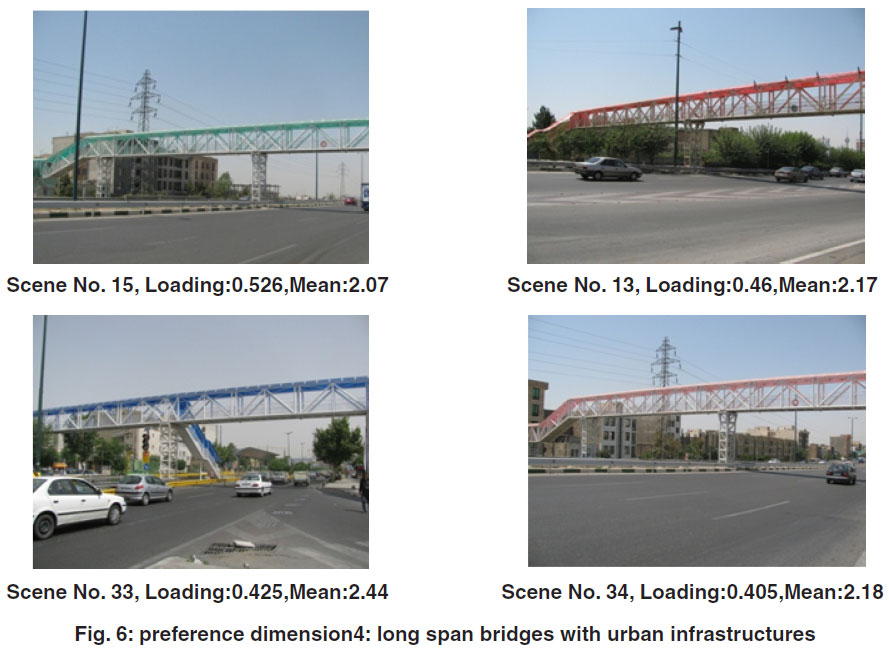 |
|
Preference Dimension 5. Sharp color of bridge on wide road: The most important common characteristics of this dimension is the sharp color of bridge ceiling followed by the wideness of the road in addition, the visible presence of the cars have created a crowded scene (Fig. 7).
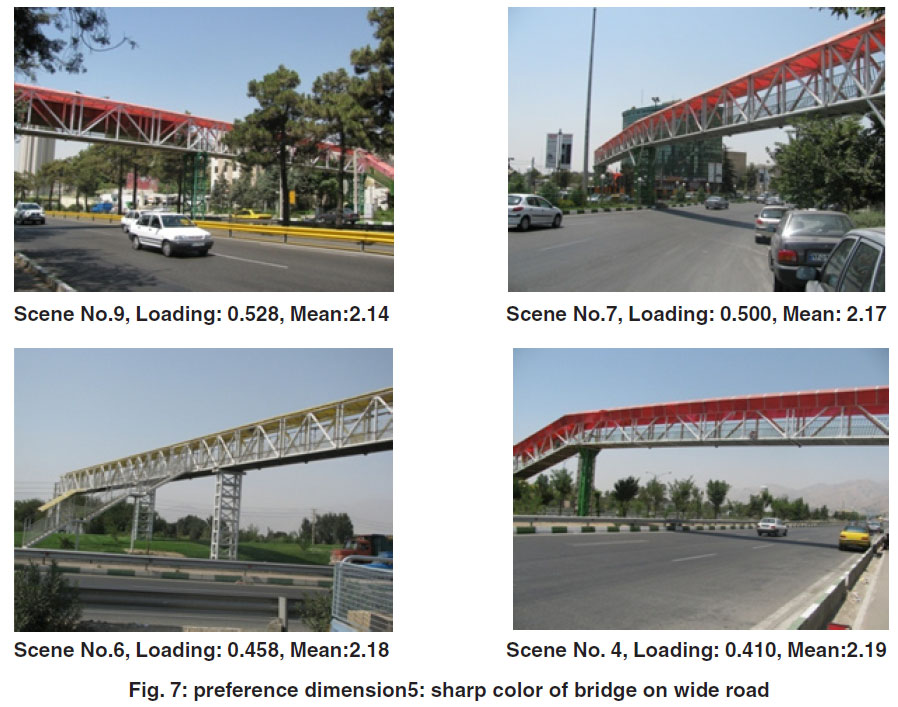 |
|
Preference Dimension 6. Light color of bridge with dividing wall in background: the most visible characteristicof the scenes in this dimension, is colorful dividing wall behind the bridges. Another factor is location of vegetation in front of the bridges. In addition the presence of cars at the scenes'backgrounds and the general lack of brightness in the scenes are another common characteristic in this dimension. (Fig. 8)
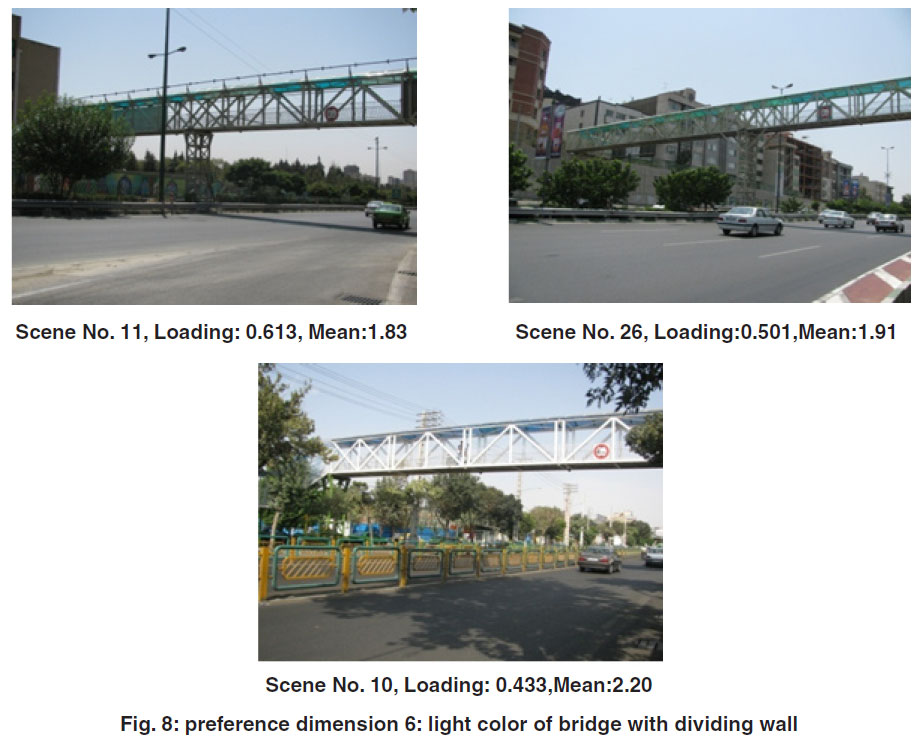 |
|
Preference Dimension 7. Advertising bridges on messy area: One of the most visible similarities forall of these scenes actually is presence of advertising signs on the bridges. It means the advertising signs exist atall of the scenes. Actually the advertising signs appear on the bridges in different styles and this is common for all this three scenes. Another common characteristic of this group of scenes is related to the density of cars, population and variety of land uses in the scenes. It means in comparison to the other scenes,this dimensionis presenting more car density, population or variety of land uses that makes this group of the scenes different from the scenes in other groups. (Fig. 9).
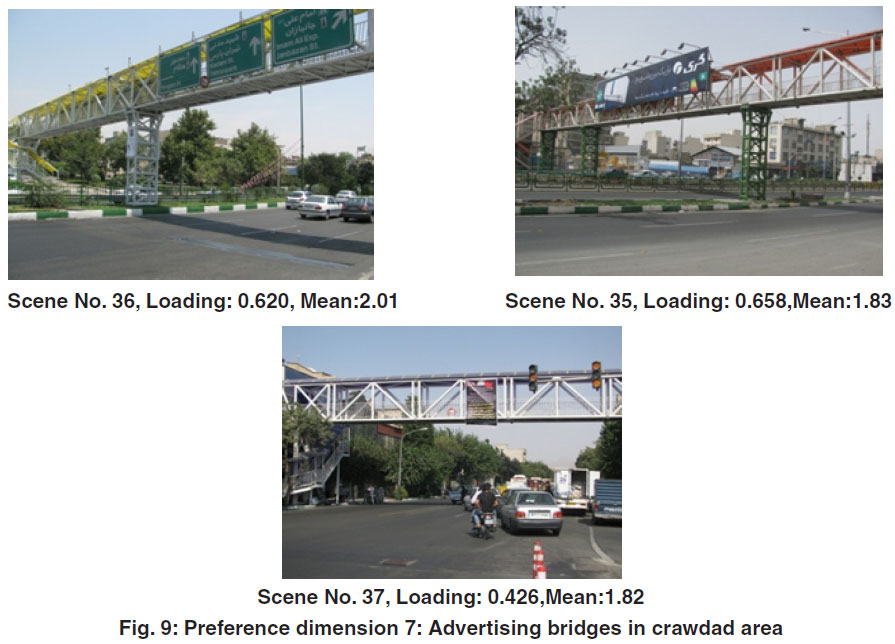 |
|
Preference Dimension 8. Opaque color of bridge in arid area: The common characteristic of this dimension is opaque color of bridge ceiling, low amount of vegetation, long span of bridges and high amount of sky view (spacious area) (Fig. 10).
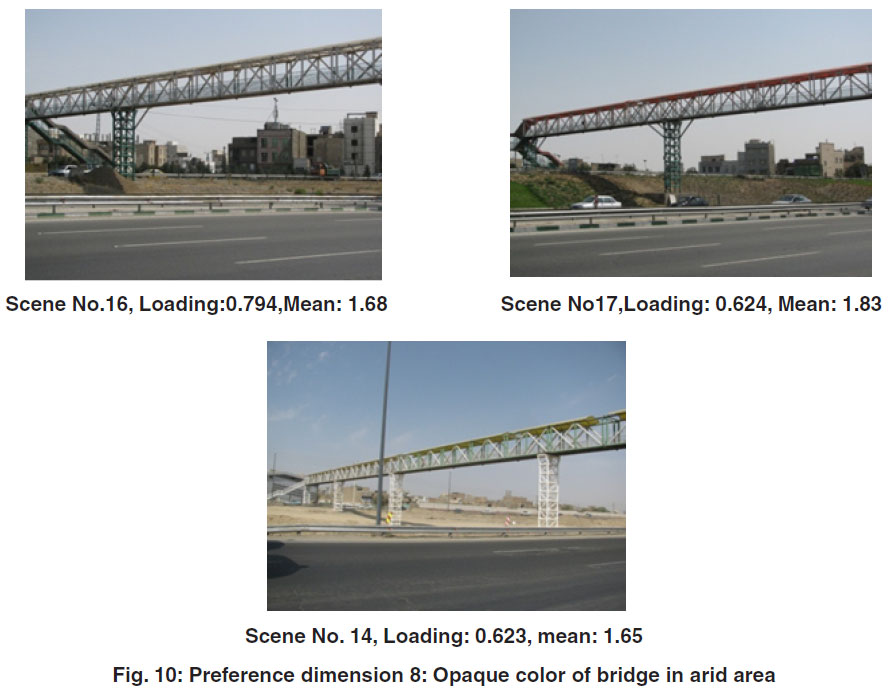 |
|
Analysis of Visual Attributes
It persumed that the visual attributes or characteristics of the surroundingsof bridges or urban settings affect on the preferences for aesthetic qualities of pedestrian bridges. As it described before, the attributes were mainly related to physical contents and their arrangements in urban settings and then the spatial configuration and environmental conditions of the scenes. The respondents were asked to rate 29 items related to the visual attributes and then the results were analysed by using a factor analysis.the scenes were ranked to reveal the strength and importance of each attribute.
Ranking of Perceived Importance of Visual Attributes on Preference
The ranking of the visual attributes has shown in Table 1. The most and the least important attributes for aesthetic preferences toward pedestrian bridges have identified. The mean scores range between 2.43 to 3.43. The most important attributes are related to the amount of vegetation and color of the bridge (Mean=3.43, Sd=0.68 and 0.74) and the least important attribute is related to the population in the scenes (Mean=2.43, Sd=0.98).
Table 1: Ranking of Means’ Score for Preferences Against Visual Attributes of Pedestrian Bridges in Urban Areas of Tehran
|
Rank |
Aesthetic Attributes of Pedestrian Bridge |
Mean |
SD |
|
1 |
Amount of vegetation |
3.43 |
0.68 |
|
2 |
Color of the bridge |
3.43 |
0.74 |
|
3 |
Quality of vegetation |
3.33 |
0.80 |
|
4 |
Presence of the vegetation |
3.27 |
0.83 |
|
5 |
Slenderness of bridge’s form |
3.22 |
0.85 |
|
6 |
Neatly and Cleanness of the scene |
3.22 |
0.85 |
|
7 |
Proportion shape of bridge ‘elements |
3.17 |
0.86 |
|
8 |
Type of vegetation (tree, shrub or flowers) |
3.15 |
0.89 |
|
9 |
Material of the bridge |
3.14 |
0.79 |
|
10 |
Position of buildings in the scene |
3.10 |
0.86 |
|
11 |
Position of vegetation |
3.06 |
0.81 |
|
12 |
Harmony of line’s orientation |
3.02 |
0.87 |
|
13 |
Connection of the existing vegetation |
3.01 |
0.86 |
|
14 |
Building’s face condition |
2.98 |
0.87 |
|
15 |
Presence of natural features (mountains and etc.) |
2.95 |
0.92 |
|
16 |
Harmony of elevation of plants |
2.95 |
0.87 |
|
17 |
Climatic situation (Light, dust, etc) |
2.94 |
0.90 |
|
18 |
Viewing to Sky |
2.92 |
0.95 |
|
19 |
Air pollution (air transparency, etc) |
2.90 |
0.98 |
|
20 |
Amount of natural features |
2.85 |
0.93 |
|
21 |
Building’s age |
2.83 |
0.99 |
|
22 |
Variety of building’s type |
2.81 |
0.86 |
|
23 |
Connection of buildings |
2.80 |
0.93 |
|
24 |
Texture of bridge’s structure |
2.78 |
0.91 |
|
25 |
Amount of building |
2.71 |
0.94 |
|
26 |
Presence of urban elements (advertisement, street signs, furniture&etc.) |
2.68 |
1.06 |
|
27 |
Presence of the buildings |
2.67 |
0.85 |
|
28 |
Amount of urban elements (advertisement, street signs, furniture&etc.) |
2.61 |
1.05 |
|
29 |
Amount of population |
2.43 |
0.98 |
Analysis of Visual Attributes Dimensions
To examine the perception patterns to recognize importance of all of these attributes and also the relationship between preference dimensions and these attributes, it was necessary to group them according to the participants' perceptions in further analysis. Consequently the visual attributes were analyzed using factor analysis and the results revealed four visual attributes dimensions (Table 2). From the mean analysis, the most important dimension was related to the bridges’ structure (Mean= 3.2, Sd=0.62) in which the color of the bridge was the most dominant factor (Mean=3.43). However, the other visual characteristics in bridges’ structure were includingtheshape,elements, slenderness of bridges' form, material and harmony of lines orientation. The second important dimension was related to vegetation of the scenes (Mean= 3.15, Sd=0.61) and the variables including presence of vegetation, their position, connection to each other, type and quality of vegetation. Other varibles were harmony between elevation of plants and cleanness of the scene.
The third dimension named the mountain and sky dimension (Mean= 2.90, Sd=0.72) in which the main obvious variables were dealing with presence and amount of mountain in the scenes and also the amount of view to the sky.
Finally, the fourth dimension for visual attributes named as building dimension which was the least important attribute in preferences for pedestrian bridges (Mean=2.82, Sd=0.6). This dimension was composed of variables related to the presence, amount and position of the buildings and also how they connected to each others.
Table 2: Revealed Dimensions for Visual Attributes of Pedestrian Bridges in Urban Areas of Tehran According to Factor Analysis.
|
Perceived Importance of Aesthetic Attributes Dimensions |
|||
|
Rank |
Dimensions |
Variable |
Loading |
|
1 |
Bridge Structure (Mean:3.2, SD: 0.60, Alpha: 0.79 )
|
- Color of the bridge (Mean: 3.43) -Proportion shape of bridge ‘elements (Mean: 3.17) -Slenderness of bridge’s form (Mean: 3.22) -Material of the bridge (Mean: 3.14) -Harmony of line’s orientation (Mean: 3.02) |
0.74 0.65 0.64 0.60 0.56 |
|
2 |
Vegetation (Mean: 3.15,SD: 0.61, Alpha:0.83)
|
-Position of veg etation(Mean: 3.06) -Connection of the existing vegetation(Mean: 3.01) -Type of vegetation (Mean: 3.15) -Presence of the vegetation (Mean: 3.27) -Quality of vegetation (Mean: 3.33) -Neatly and Cleanness of the scene(Mean: 3.22) -Harmony of elevation of plants(Mean: 2.95) - Amount of vegetation (Mean: 3.43 ) |
0.77 0.68 0.65 0.59 0.57 0.53 0.53 0.50 |
|
3 |
Mountain & Sky (Mean:2.90 SD: 0.72, Alpha:0.66) |
-Amount of natural features(Mean: 2.85) -Presence of natural features (Mean: 2.95) -Viewing to Sky(Mean: 2.92) |
0.79 0.76 0.40 |
|
4 |
Buildings (Mean:2.82, SD: 0.67, Alpha: 0.73)
|
-Connection of buildings (Mean: 2.80) -Amount of building (Mean: 2.71) -Position of buildings in the scene (Mean: 3.10) -Presence of the buildings (Mean: 2.67) - Building face condition (Mean: 2.98) - Building age condition (Mean: 2.83) - Variety of building’s type (Mean: 2.81) |
0.72 0.64 0.63 0.58 0.50 0.42 0.47 |
Relationships between Preference Dimensions and Visual Attributes
This study attempted to identify the relationship between the imoprtant visual attributes and preference dimensions for pedestrian bridges. To identiy factor(s) that could best predict a particular preference dimension, a multiple linear regression analysis was applied. All the analysis were tested at 95% significance level.
Multiple regression analysis was done with an enter method because the method can rank the independent variables (visual attributes) according to their regression magnitude (r2). For all the study model, no collinearity effects were found as all Variance Inflation Factor (VIF) is in between 1.14 and 2.34, and the VIF had to be lower than 10 with tolerance bellow 0.126 27. The results for regression analysis between preference dimensions and visual attributes revealed some significant relationships. For preference dimension 1 (sharp colors with different form of bridges), the best predictor is “color of bridge” (β=+0.19, p<0.001), followed by “viewing to sky” (β=-0.18, p<0.001), “harmony of plants’ height” and “material of bridge” (β=-0.13, p<0.001), “presence of mountain” in the scene (β=+0.13, p<0.001) and then “proportion shape of bridge” (β=-0.12, p<0.001). Among all attributes, the sign for beta and then thedirection of relationship are positive for “color of the bridge” and “presence of mountain” which means these two attributes can significantly predict the perferences for this dimension.
In preference dimension 2 (sharp blue color of bridges with connected buildings around),“harmony of line orientation” (β=-0.15, p<0.001), “viewing to sky” (β=-0.14, p<0.001) “position of building” (β=-0.13, p<0.001) and then “material of the bridge” (β=-0.12, p<0.001) are the best predictors for the preferences.
Meanwhile, for dimension 3 (light blue color of bridges with connected vegetation around) is related with “harmony of line orientation” (β=-0.16,p<0.001), followed by “proportion shape of bridge” and “material of the bridge” (β=-0.15, p<0.001), “viewing to sky” (β=-0.13, p<0.001).
Four factors can significantly predict preference dimension 4 (long span bridges with urban infrastructures around) as: “presence of vegetation” and “viewing to sky” (β=-0.15, p<0.001) followed by “connection of vegetation”, and “material of the bridge” (β=-0.14, p<0.001). For preference dimension 5 (sharp color of bridge on wide road), “building’s age” (β=-0.18, p<0.001), “viewing to sky” (β=-0.15, p<0.001), and then “quality of vegetation” (β=-0.14, p<0.001) are the top predictors. In preference dimension 6 (light color of bridges with dividing walls in background), “building’s face condition” and “color of bridge” (β=-0.18, p<0.001) are the best predictors that followed by “building’s age” (β=-0.13, p<0.001). The best predictor for preference dimension 7(advertising bridges on messy area) is “position of building” (β=-0.21, p<0.001) Followed by “material of the bridge” (β=-0.15, p<0.001) and then “variety of buildings” and “building’s age” (β=-0.12, p<0.001).
Finally, eleven factors can significantly predict preference dimension 8 (opaque color of bridge in arid area). The best predictors related to “color of bridge” (β=-0.26, p<0.001) followed by “building’s face condition” (β=-0.20, p<0.001) and then “cleanliness of the scenes” (β=-0.19, p<0.001), “proportion shape of bridge”, “type of vegetation”, “position of building”, “viewing to sky” (β=-0.18, p<0.001), “building’s age” (β=-0.17, p<0.001) “amount of vegetation”,“presence of mountain” (β=-0.13, p<0.001) and “slenderness of bridge” (β=-0.11, p<0.001).
Discussion
The findings, first,revealed that people react differently to the similar structure of pedestrian bridges in diverse urban landscapes and the different visual attributes in urban landscapes can significantly influence their preferences. Therefore, the finding is in line with the theory of context sensitive design, theories of Alexander (wholeness theory and theory of goodness of fit) and finally the theory of Lynch (good city form) in which they all argued that the visual characteristics of the context have an important role onvisual aesthetic preference of an urban element28. Furthermore, the general finding using this approach indicated that the preference mean scores for pedestrian bridges are generally low. (The highest mean for the pedestrian bridge was 2.61 out of 4.0 on a Likert scale and it was concluded that people don’t prefer pedestrian bridges highly in Tehran.Therefore based on the result of this study people generally didn’t prefer pedestrian bridges in urban areas of Tehran in high degree and it could be attributed to their appearance, since they suffer the low aesthetic qualties. the result of this part also is in line with the theory of Lynch who argued regarding relationaship beween functionality and apperance of urban elements.28,12
On the other hand, the content analysis of the preference dimensions revealed that people prefer strongly the scenes that contain bridges with sharp colors. This can be seen in preference dimensions 1 as the most preferred dimension which included the scenes with sharp color of pedestrian bridges in comparison to preference dimension 8 as the least preferred dimensions which contains opaque colors. Therefore in both the most and least preferred dimensions (preferences dimension 1 and 8) color of the bridge is the best predictor and have a determinant role on preferences in any type of environment. In addition, it could be seen in the most prefered scenes include more vegetation density in comparison to the other scenes. Therefore there are another potential factor that could affects the preferences for pedestrian bridges related to presence of vegetation and greenery of the scene. Based on comparison between preference dimension1 as the most preferredand preference dimension 8 as the least preferred one,the importance of vegetation in the scenes is obvious. Another potential factor that affects preferences for pedestrian bridges in urban areas,related to presence of mountain in the scene. It can be seen in preference dimension 1 and the most preferred scene (scene 31) which contain an obvious amount of mountain in the scene. Another content that affect preferences is amount of sky view in the scenes. People generally prefer the scenes that contain lower percentage of sky view. It can be seen through comparison of preference dimension 1 with low percentage of sky view and preference dimension 8 with high percentage of sky view. Therefore ranking of preference dimensions according to their mean scores, briefly indicates that people highly prefer the sharp colors of pedestrian bridges and they don't like the scenes with low vegetation.
Further, other important factors that can affect the aesthetic preference for pedestrian bridgeswere identified as buildings, amount of sky view and presence of mountain.Meanwhile, previous researchers have already insisted on the role of these factors in aesthetic preferences of landscape. On the other hand, the results from analysis of the visual attributes, indicated that participants generally perceive all of the aforementioned attributes as important factors on aesthetic qualities of pedestrian bridges. Second, the finding can support the results from the previous part of this study as preference survey analysis, which shows the scenes with sharp colors which create a contrast with surrounding environment are the most preferred scenes. Presence of mountain, position of buildings and their facial situation are another potential visual attributes that identified through this study whichthey can affect the public preferences for pedestrian bridges in urban areas.
Similarly the multiple regression analysis also concluded that color of pedestrian bridges, amount of vegetation, amount of sky view, presence of mountain and position and order of buildings in the scenes affect people’s preferences for pedestrian bridges in urban landscapes of Tehran.
All the results are completely in line with Arriaza et al., who argued that percentage of vegetation and providing a color contrast, and also presence of mountain in the scene can improve potentially the visual qualities in rural landscape29. In terms of color, it is one of the variables that can define the visual and aesthetic aspects of any object. Bishopand Ca˜nas argued that there are a strong positive association between preference and certain landscape attributes specially colors in the landscape.30,31,32 It is presumed that the color provide contrast within the visual scene thus make the attractive environment. Garc´Ä±a et al., and Espa˜nol also argued that sharp colors and shine surfaces tend to attract the attention of people more.33,32 This findings also supported the findings who argued about the importance of consideration of color as a potential factor in aesthetic qualities specifically for pedestrian bridges.1,34,35 Nevertheless, Minnesota Department of Transportation in their report about “Aesthetic Guidelines for Bridge Design” argued that creating harmony or contrast between color of bridges and their environment depend on the purpose of the project and should also be considered the seasonal changes and day lighting situation.3
Further in terms of vegetation,they are strongly preferred in urban areas and they found a significant positive impact of vegetation on environmental preferences.Therefore the results from this part can support the theories regarding the importance of vegetation in aesthetic qualities and concluded that it can affect people preference for the pedestrian bridges.
In addition, mountains considered as a benchmark of a beautiful landscape and they have a positive influence on preferences.29,44 C. Menn had already argued about bridges scenes in combination with mountain as background,while they create a contrast with bridge structure and the aesthetic values is dramatically increased2 herewith, the study resulted in interesting similarities between the results from other related studies in terms of aesthetic qualities of pedestrian bridges in urban areas.
Consequently, the results are in line with the studies that identified the “area of sky”as a negative predictor for visual preference of landscape.45,4647 According to Hammitt et al., this happens because the sky area is a surrogate for other features, specifically in absence of attractive onessuch as ridges, rolling plateau and water. According to Anderson and Schroeder, high amount of sky view always comes along with the view of overhead poles and wires, and would result reduction of tree cover and affectpreferences in negative direction. Therefore, the sky is considered as a background for landscapes, but it seems to be perceived disassociated from the landscape. Itmight be related to three reasons which are the scene complexity, visibility of urban facilities which are not interesting and finally the polluted sky.45
In terms of building facade, age and also their position in the scenes, there are some researches that have interesting findings in line with the findings from this study. According to Stamp and Miller (1993), presence or absence of buildings doesn’t make sense for visual preferences in landscape. however, it is argued that presence of buildings in landscapes has an influence on landscape aesthetic appreciation.39,49,50 These statements can support the results especially for the scenes with lower preference scores because presence of buildings is very low in these scenes.
Conclusion
This study revealed that the pedestrian bridges in Tehran are not appreciated by people and it is concluded that this occurs, because these pedestrian bridges are not context-sensitive. Accordingly, this study found that preferences for similar pedestrian bridges differ with change in visual characteristics of urban areas where the bridges are located.It means that the visual characteristics of urban contexts can potentially affect aesthetic perception of pedestrian bridges in urban areas.The factors recognized as the color of bridge, amount of vegetation, presence of mountain, amount of sky view and then position of buildings in the surrounding landscapes. On the other hand, to improve the functionalityof pedestrian bridges it seems crucial to consider their appearance and visual characteristics. and then in order to enhance their visual aesthetic preference, this study conclude that they should be in harmony with their contextsand their sorrounding environmnets. In addition, they should have a color contrast with the area and high quality vegetation should be provided. If any viewing to the mountain is available,the location of bridges are also important. Finally design a different and intresting form of bridges which provide high amount of sky view and craetes contrsating forms can improve the aestheic qualities and thus function of pedestrian bridges.
The results could be foundation of thinking process for designers to design more functional bridges which are preferable by people.
Acknowledgements
This paper actually, was based on a PhD research that was supported by the University of Putra Malaysia (UPM), Faculty of Design and Architecture (FRSB) and The authors gratefully acknowledges all the Faculty members regarding their cooperation and guidance.
References
- Gottemoeller, F. 2004. Bridgescape: The Art of Designing Bridge. New Jersey: John Wiley & Sons, Inc.
- Menn, C. 1991. Bridge Aesthetic Around the World. Aesthetic in Bridge Design. Washington DC. USA: Transportation Research Board, National Research Council. pp. 177-188.
- Aesthetic Design Guideline. 1995. Minnesota Department of Transportation, Office of Technical Support, Site Development Unit. Minnesota Department of Transportation: U.S.A.
- Federal Highway Administration, U.S. Department of Transportation, 2002. Context Sensitive Design and Thinking Beyond the Pavement. Washington, DC.
- Grob, J. 2001. Design Principles and Guidelines for Transportation Project; Getting Projects Built. U.S.A.: American Society of Highway Engineers, SCANNER Newsletter.
- Leonhardt, F. 1984. Bridges: Aesthetics and Design. Cambridge: The M.I.T. Press.
- Farshidfar, R., Ranjbar, A. Investigating the effects of Architecture Residential Recreational Complex on Tourism Industry in Iran. Res. J. Recent Sci., 1(12): 25-30.
- Reich, Y. 1993. A Model of Aesthetic Judgment in Design. Artificial and Intelligence Engineering, 8: 141-153.
- Tang, H. C. 1991. Bridge Aesthetic Around the World. Philosophical Basis for Chinese Bridges Aesthetic, Washington DC., USA: Transportation Research Board, National Research Council, pp. 167-177.
- Zuk, W. 1990. An Expert System for the Esthetic Rating of Bridges. Landscape and Urban Planning 22, pp. 45-58.
- Golabchi, M. 2005. Design Pedestrian Bridges of Tehran: In five selected areas. Tehran, Iran: Beautification Organization of Tehran.
- Nikoomaram, H., Vazifedoost, H., & Khani, S. 2008. Evaluation of Functional Efficiency of Pedestrian Bridges in urban areas of Tehran. City Identity, 2: 3-12.
- Daniel, T. C. 2001. Whether Scenic Beauty? Visual Landscape Quality Assessment in the 21st Century. Landscape and Urban Planning, 54:267-281.
- Strumse, E. 1996. Demographic differences in the visual preferences for agrarian landscapes in western Norway. Journal of Environmental Psychology, 16(1): 17-31.
- Hull, R. B., & Harvey, A. 1989. Explaining the emotion people experience in suburban parks. Environment and behavior, 21(3): 323-345.
- Bernaldez, F.G., Ruiz, J.P., Benayas, J., & Abello, R.P. 1988. Real landscapes versus photographed landscapes: preference dimensions. Landscape Resources, 13: 10-11.
- Hull R. B. & Stewart W. P. 1992. Validity of Photo-Based Scenic Beauty Judgments. Journal of Environmental Psychology, 12: 101–14.
- Kaplan, S. 1987. Aesthetics, affect and cognition: environment preference from an evolutionary Perspective. Environmental Behavior, 19(1): 3-32.
- Law, C. S., & Zube, E. H. 1983. Effects of Photographic Composition on Landscape Perception. Landscape Resources, 8: 22– 23.
- Stamps, A. E., & Miller, S. D. 1993. Advocacy membership, design guidelines, and predicting preferences for residential infill designs. Environment and Behavior, 25(3): 367-409.
- Sarmad, Z., Bazargan, A. & Hejazi, E. 1999. Research Methods in Behavioral Science. Tehran. Iran: Agah Press.
- Jalalian M. 2012. Writing an eye-catching and evocative abstract for a research article: A comprehensive and practical approach. Electronic Physician, 4(3): 520-524. Available online at: http://www.ephysician.ir/2012/520-524.pdf
- Jalalian M, Danial A.H. 2012. Writing for academic journals: A general approach. Electronic Physician 4(2), pp. 474-476. Available online at: http://www.ephysician.ir/2012/474-476.pdf
- Krejcie, R.V., & Morgan, D.W. 1970. Determining Sample Size for Research Activities. Educational and Psychological Measurement, 30: 607-610.
- Kaplan, R., & Herbert, E. J. 1987. Cultural and sub-cultural comparisons in preferences for natural settings. Landscape and Urban Planning, 14: 281-293.
- Ho, R. 2006. Handbook of Univariate and Multivariate data analysis and interpretation with SPSS. New York: Taylor & Francis Group.
- Pallant, J. 2005. SPSS survival manual. USA: Open Univ. Press.
- Lynch, K. 2002. Theory of good city form. New York: Van Nostrand Reinhold.
- Arriaza, M., Cañas-Ortega, J.F., Cañas-Madueño, J.A.& Ruiz-Aviles, P., Assessing the Visual Quality of Rural Landscapes, 2004. Landscape and Urban Planning, 69: 115–125.
- Bishop, I. D. 1997. Testing perceived landscape colour difference using the Internet. Landscape and Urban Planning, 37: 187–196.
- Ca˜nas, I., Ayuga, E., & Ayuga, F. 2009. A contribution to the assessment of scenic quality of landscapes based on preferences expressed by the public. Land Use Policy, 26: 1173–1181.
- Garcı´a, M. L., Herna´ndez, B. J., & Ayuga, F. 2003. Analysis of the exterior colour of agroindustrial buildings: a computer aided approach to landscape integration. Journal of Environmental Management, 69: 93–104.
- Espan˜ ol, I. 1995. Impacto Ambiental (Environmental Impact). Canales y Puertos, Madrid: E.T.S.I. Caminos.
- Leonhardt, F. 2000. Bridge Engineering Handbook. In Wai-Fah Chen, & Lian Duan (Eds), Bridge Aesthetics Basics (chapter 2). Boca Raton: CRC Press.
- Listavich, S. T. 1995. The Development of Aesthetic Guidelines for Short and Medium Span Texas Bridge Systems. Unpublished Master’s thesis, The University of Texas at Austin.
- Herzog, T. R. 1989. A cognitive analysis of preference for urban nature. Journal of Environmental Psychology, 9: 27-43.
- Hull, R. B., & Revell, G. R. 1988. Cross-cultural comparison of landscape scenic beauty evaluations: a case study in Bali. Journal of Environmental Psychology, 9: 177-191.
- Kaplan, R. 1983. The role of nature in the urban context. In I. Altman & J. F. Wohwill (Eds.), Behavior and Natural Environment. New York: Plenum Press. pp. 127-162.
- Louiza, Rodrigues. Artificial and Natural Regeneration of the Forests of Bombay Presidency: 1838 to 1860Res.J.Recent Sci.,1(2): 113-118.
- Mostafa M. Rady and Maybelle S. 2012. Gaballah, Improving Barley Yield Grown Under Water Stress Conditions J.Recent Sci., 1(6): 1-6.
- Nasar, J. L. 1997. The Evaluative Image of the City. Thousand Oaks, CA: Sage.
- Tavafi, S., H.Arzani, H.M. Mohammadi, M.Jafari and S.Babaie. 2014.An Investigation on the Trend of Changes in Land use/Plant Coverage Case Study in Arangeh-watershed in Alborz Province of Iran, Res. J. Recent Sci., 3(2): 74-80.
- Sheets, V. L., & Manzer, C. D. 1991. Affect, cognition, and urban vegetation some effects of adding trees along city streets. Environment and Behavior, 23(3): 285-304.
- Beza, B. 2010. The Aesthetic Value of a Mountain Landscape: A study of the Mt. Everest Trek. Landscape and Urban Planning, 97: 306-317.
- Anderson, L. M., & Schroeder, H. W. 1983. Application of wildland scenic assessment methods to the urban landscape. Landscape Planning,10: 219-237.
- Buhyoff, G. J., Gauthier, L. J., & Wellman, J. D. 1984. Predicting scenic quality for urban forests using vegetation measurements. Forest Science, 30(1): 71-82.
- Hiremath Deepa B. and Shiyani R.L. Adapting Gujarat to Climatic Vulnerabilities: The Road Ahead, Res.J.Recent Sci., 1(5): 38-45.
- Hammitt, W. E., Patterson, M. E., & Noe, F. P. 1994. Identifying and predicting visual preference of southern Appalachian forest recreation vistas. Landscape and Urban Planning, 29: 171–183.
- Sayadi, S., González-Roa, M. C., & Calatrava-Requena, J. 2009. Public preferences for landscape features: the case of agricultural landscape in mountainous Mediterranean areas. Land Use Policy, 26(2): 334–344.
- Groat, L. 1984. Public opinions of contextual fit. Architecture, 11: 72–75.







